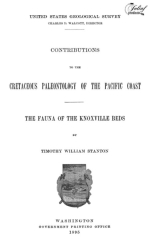Добрый день, Коллеги. Важное сообщение, просьба принять участие. Музей Ферсмана ищет помощь для реставрационных работ в помещении. Подробности по ссылке
Contributions to the cretaceous paleontology of the Pacific coast. The fauna of the Knoxville beds / Представленность в палеонтологии мелового периода тихоокеанского побережья. Фауна Ноксвиллских отложений
Previous to the publication in 1869 of Vol. II, Palaeontology of California, the deposits on the Pacific Coast now recognized as Cretaceous were not divided into groups or formations. In that volume Professors Whitney and Gabb gave the name Shasta group to the complex series of Lower Cretaceous beds which they recognized to be of different ages, probably from the Keocomian to the Gault, inclusive. They also proposed the names Chico group, Martinez group, and Tejon group for the beds overlying the Shasta in the order named. Of these the Tejon is now generally believed to be of Eocene age, and the Cretaceous portion of the ill-defined and heterogeneous Martinez group is inseparable from the Chico.In 1885 Dr. C; A. White1 and Dr. G. F. Becker1 recognized two divisions of the Shasta formation, which they called the Knoxville beds and the Horsetown beds. The former, which is especially characterized by the abundant occurrence of Aucella, was named from the village of Knoxville, in the quicksilver mining district of Кара County, Cal., where it is well developed, while the typical localities of the Horsetown beds, characterized by a different fauna, rich in ammonites, were given as the north fork of Cottonwood Creek and Horsetown, in Shasta County. <...>




